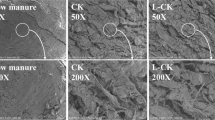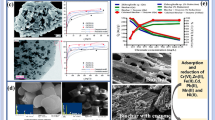Abstract
Understanding the effects of organic acids (OA) on the transformation of Fe and Mn to surface water from the weathering coal gangue is of great benefit to risk assessment and remediation strategies for contaminated water and soil. Based on the investigation on surface water in the central coal districts of the Guizhou Province, 18 water samples were collected for heavy metal analysis. The results indicated that the pH value of surface water is low (3.11–4.92), and Fe concentration (1.31–5.55 mg L−1) and Mn concentration (1.90–5.71 mg L−1) were, on average, 10.86 and 34.33 times the limit of Surface Water Quality Standards, respectively. In order to evaluate the effects of the OA on the dissolution of Fe and Mn from the weathering coal gangue, column elution and batch leaching experiments were conducted. The results show that the low molecular weight of organic acids (LMWOAs, i.e., oxalic, tartaric, malic and citric acids) and fulvic acids significantly accelerated the dissolution of Fe and Mn; in addition, when the concentration of OA reached 25 mmol L−1, the concentrations of Fe, and Mn were 1.14–67.08 and 1.11–2.32 times as high as those in 0.5 mmol L−1 OA, respectively. Furthermore, the migration of Fe and Mn was significantly influenced by the pH and Eh, especially for Fe; the ion Mn was dissolved from the gangue more easily than the ion Fe in the column leaching, which was contrary to the results of batch leaching.





Similar content being viewed by others
References
Alin S, Xueyuan L, Shongrong W (1997) The composition characteristics of low molecular weight organic acids in soil and their roles on soil material cycling. Plant Nutr Fertil Sci 3(4):363–371 (in Chinese with English abstract)
Almaroai YA, Usman ARA, Ahmad M, Kimd K, Vithanageae M, Oka YS (2013) Role of chelating agents on release kinetics of metals and their uptake by maize from chromated copper arsenate-contaminated soil. Environ Technol 34:747–755
An CJ, Huang GH, Wei J, Yu H (2011) Effect of short-chain organic acids on the enhanced desorption of phenanthrene by rhamnolipid biosurfactant in soil-water environment. Water Res 45:5501–5510
Atalay YB, Carbonaro RF, Di Toro DM (2009) Distribution of proton dissociation constants for model humic and fulvic acid molecules. Environ Sci Technol 43(10):3626–3631
Backes CA, Pulford ID, Duncan HJ (1985) Neutralization of acidity in colliery spoil possessing pH-dependent change. Reclam Reveg Res 4:145–153
Caiying N, Guangming T, Yongming L, Yingxu C (2004) Influences of organic compounds and nitric acid solutions on release of copper, zinc and lead from a mixed metal-polluted agricultural soil. Acta Pedol Sin 41(2):237–244 (in Chinese with English abstract)
Changyuan T, Pan W, Xiuzhen T (2009) The basin acidification affected by AMD: a case study in Xingren county, Guizhou, China. Carsol Sin 28(2):135–143
Clístenes Williams AN, Dula A, Xing BS (2006) Comparison of natural organic acids and synthetic chelates at enhancing phytoextraction of metals from a multi-metal contaminated soil. Environ Pollut 140:114–123
Debela F, Arocena JM, Thring RW, Whitcombe T (2010) Organic acid-induced release of lead from pyromorphite and its relevance to reclamation of Pb-contaminated soils. Chemosphere 80(4):450–456
Egli M, Sartori G, Mirabella A, Giaccai D (2010) The effects of exposure and climate on the weathering of late Pleistocene and Holocene Alpine soils. Geomorphology 114(3):466–482
Ettler V, Vrtišková R, Mihaljevič M, Šebekb O, Grygarc T, Drahota P (2009) Cadmium, lead and zinc leaching from smelter fly ash in simple organic acids-simulators of rhizospheric soil solutions. J Hazard Mater 170:1264–1268
Fox TR, Comerford NB, McFee WW (1990) Phosphorus and aluminum release from a spodic horizon mediated by organic acids. Soil Sci Soc Am J 54:1763–1769
Guoyong H, Qingling F, Jun Z, Tianying W, Hongqing H (2014) Effects of low molecular weight organic acids on speciation of exogenous Cu in an acid soil. Environ Sci 35(8):3091–3095 (in Chinese with English abstract)
Haibo L, Fang L, Jian Z, Xiaoyan Z, Silin C (2012) Available heavy metal concentrations in dominant species rhizospheres of natural vegetations in coal gangue dumps. Chin J Ecol 31(12):3207–3212 (in Chinese with English abstract)
Hailin Y, Bohan L (2010) Extraction condition for heavy metals from contaminated soil by using low molecular organic acids. J Agro-Environ Sci 29(12):2330–2337 (in Chinese with English abstract)
Heikkinen PM, Räisänen ML, Johnson RH (2009) Geochemical characterisation of seepage and drainage water quality from two sulphide mine tailings impoundments: acid mine drainage versus neutral mine drainage. Mine Water Environ 28:30–49
Huan L, Yunguo L, Guangming Z, Jieli X, Bohong Z, Xiaofei T, Dafei W, Zhichao S, Jian N, Zhengjiang J, Chao G, Wei L, Shufan W (2015) Mitigation mechanism of Cd-contaminated soils by different levels of exogenous low-molecular-weight organic acids and Phytolacca americana. RSC Adv 5(56):45502–45509
Jinfeng S, Xiaoyang C, Yong L (2004) Determination of organic acids in forest litters by a capillary gas chromatography. Sci Silvae Sini 40(4):185–188 (in Chinese with English abstract)
Jinfeng S, Xiaoyang C, Zhengquan W (2011) Effects of low molecular-weight organic acids P, Fe and K availablity of dark brown forest soils and absorption of forest seedlings. J Soil Water Conserv 25(1):123–127
Jiewen Y, Laiyuan Z, Liming L (2015) Influence of aqueous Fe(III) on release of Mn(II) from low molecular weight organic acid promoted dissolution of an Oxisol and γ-MnO2. Environ Earth Sci 74(2):1625–1632
Jones DL (1998) Organic acids in the rhizosphere-a critical review. Plant Soil 205:25–44
Jones DL, Darrah PR (1994) Role of root derived organic acids in the mobilization of nutrients from the rhizosphere. Plant Soil 66:247–257
Kang K, Shin HS, Park H (2002) Characterization of humic substances present in landfill leachates with different landfill ages and its implications. Water Res 36(16):4023–4032
Kinniburgh DG, Milne CJ, Benedetti MF, Pinheiro JP, Filius J, Koopal LK, Van Riemsdijk WH (1996) Metal ion binding by humic acid: application of the NICA-Donnan Model. Environ Sci Technol 30(5):1687–1698
Kögel-Knabner I, Amelung W, Cao Z, Fiedler S, Frenzel P, Jahn R, Kalbitz K, Kölbl A, Schloter M (2010) Biogeochemistry of paddy soils. Geoderma 157(1–2):1–14
Lee SS, Nagy KL, Park C, Fenter P (2011) Heavy metal sorption at the muscovite (001)–fulvic acid interface. Environ Sci Technol 45(22):9574–9581
Lin G, Teresa JC (2015) Remediation of AMD contaminated soil by two types of reeds. Int J Phytorem 17(4):391–403
López-Bucio J, Nieto-Jacobo MF, Ramírez-Rodríguez V (2000) Organic acid metabolism in plants: from adaptive physiology to tansgenic varieties for cultivation in extreme soils. Plant Sci 160:1–13
Mastrocicco M, Prommer H, Pasti L, Palpacelli S, Colombani N (2011) Evaluation of saline tracer performance during electrical conductivity groundwater monitoring. J Contam Hydrol 123(3–4):157–166
Navarro Flores A, Martínez Sola F (2010) Evaluation of metal attenuation from mine tailings in SE Spain (Sierra Almagrera): a soil-leaching column study. Mine Water Environ 29:53–67
Novikova SP, Gas’kova OL (2013) Influence of natural fulvic acids on the solubility of sulfide ores (experimental study). Russ Geol Geophys 54(5):509–517
Ololade IA, Oladoja NA, Alomaja F, Ololade OO, Olaseni EO, Oloye FF, Adelagun ROA (2015) Influence of organic carbon and metal oxide phases on sorption of 2, 4, 6-trichlorobenzoic acid under oxic and anoxic conditions. Environ Monit Assess 187(1):4170
Pan W, Changyuan T, Chongqiang L, Lijun Z, Tingquan P, Lijuan F (2009) Geochemical distribution and removal of As, Fe, Mn and Al in a surface water system affected by acid mine drainage at a coalfield in Southwestern China. Environ Geol 57:1457–1467
Rengel Z, Marschner P (2005) Nutrient availability and management in the rhizosphere: exploiting genotypic differences. New Phytol 168:305–312
Smuda J, Dold B, Spangenberg JE, Friese K, Kobek MR, Bustos CA, Pfeifer H (2014) Element cycling during the transition from alkaline to acidic environment in an active porphyry copper tailings impoundment, Chuquicamata, Chile. J Geochem Explor 140:23–40
Tani M, Higashi T, Nageztsuka S (1995) Low molecular weight aliphatic acids in some andisols of Japan. In: Huang PM, Berthelin J, Bollag JM, McGill WB, Page AL (eds) Envionmental impact of soil componnent interaction. Lewis, Chelsea
Vaněk A, Komárek M, Chrastný V, Galušková I, Mihaljevič M, Šebek O, Drahota P, Tejnecký V, Vokurková P (2012) Effect of low-molecular-weight organic acids on the leaching of thallium and accompanying cations from soil-A model rhizosphere solution approach. J Geochem Explor 112:212–217
Veselý T, Tlustoš P, Száková J (2012) Organic acid enhanced soil risk element (Cd, Pb and Zn) leaching and secondary bioconcentration in water lettuce (Pistia Stratiotes L.) in the rhizofiltration process. Int J Phytorem 14(4):335–349
Wei W, Fang L, Yangzhou X (2009) The vegetation investigation and analysis of coal mine abandons in maiping of Huaxi District. J Guizhou Univ 26(2):132–135 (in Chinese with English abstract)
Xi F, Dalun T, Wenhua X, Baoyu C (2004) Absorption, accumulation and dynamic of heavy metal elements in Pinus massoniana plantation in guangxi. Guihaia 24(5):437–442 (in Chinese with English abstract)
Xiangfei M (2015) Study on variation of Fe and Mn content in fluctuation zone of groundwater level: An example in Shenyang Huangjia water source. Jilin University, Jilin
Yanyu W, Shaoqi Z, Xiuya Y, Dongyu C, Ke Z, Fanghui Q (2011) Transformation of pollutants in landfill leachate treated by a combined sequence batch reactor, coagulation, Fenton oxidation and biological aerated filter technology. Process Saf Environ Prot 89(2):112–120
Yingqun M, Quan W, Yanwen Q, Binhui Z, Lei Z, Yanming Z (2013) Migration chracteristic of heavy metals in soil around Hongtoushan copper mining area in Liaoning Province. Environ Pollut Control 09:1–8 (in Chinese with English abstract)
Yongzhen D, Zhi’an L, Bi Z (2005) Low molecular weight organic acids and their ecological roles in soil. Soils 37(3):243–250 (in Chinese with English abstract)
Yuanchun Y, Jian Y, Li F, Defeng J (2007) Organic Acids Exudation from the Roots of Cunninghamia lanceolata and Pinus massoniana Seedlings Under Low Phosphorus Stress. J Nanjing For Univ (Natural Sciences Edition) 31(2):9–12 (in Chinese with English abstract)
Yunlong M, Qingru Z, Hao H, Jie P, Xiaoyan L, Bohan L (2008) Effect of low molecular weight organic acids on desorptions of Pb, Cd, Cu and Zn from soils. Chin J Soil Sci 39(6):1419–1423 (in Chinese with English abstract)
Zhi D, Chongqiang L, Zhong L (2001) Experimental simulation of chemical activity of heavy metals in coal gangue. J South China Univ Technol (Natural Science Edition). 29(12):1–5 (in Chinese with English abstract)
Zhuhong D, Daqiang Y, Xin H, Xi W, Liangyan X (2008) Extraction of heavy metals and mineral elements in agricultural soils around mine area using biodegradable and non-biodegradable chelator. J Agro-Environ Sci 27(5):1774–1778 (in Chinese with English abstract)
Acknowledgments
This project was sponsored by The Innovative Talent Team Construction Project for Science and Technology of Guizhou Province (Project Number [2012]4005).
Author information
Authors and Affiliations
Corresponding author
Rights and permissions
About this article
Cite this article
Chen, Z., Liu, F., Bu, T. et al. Effects of organic acids on dissolution of Fe and Mn from weathering coal gangue. Acta Geochim 35, 316–328 (2016). https://doi.org/10.1007/s11631-016-0104-8
Received:
Revised:
Accepted:
Published:
Issue Date:
DOI: https://doi.org/10.1007/s11631-016-0104-8




